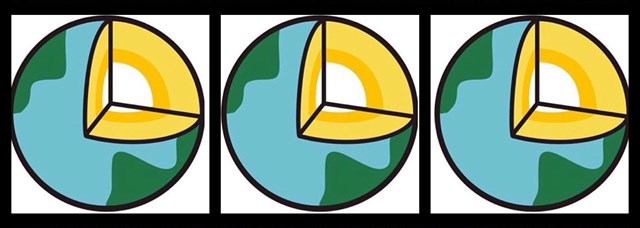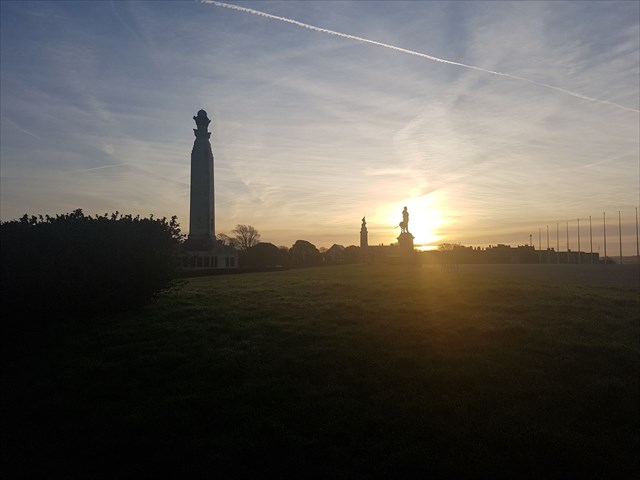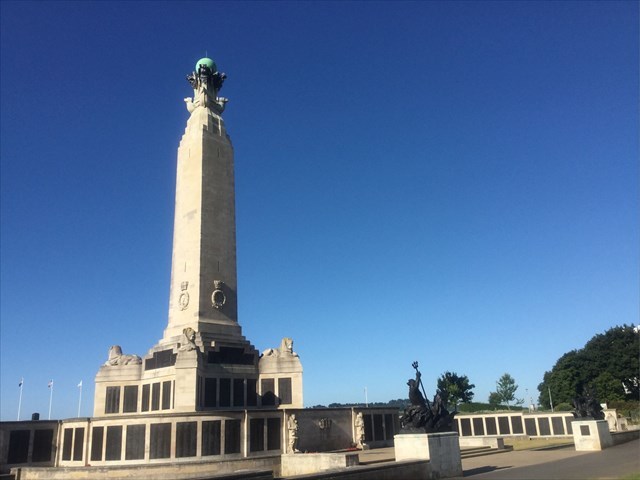Plymouth Naval Memorial EarthCache

In this EarthCache we are going to look at the stone in which the monument is built from. Portland Stone.
Portland Stone
Portland stone has been used in buildings and monuments throughout the world, examples of this can be found in both the UK and the USA. The stone has been used to construct famous buildings like St Paul's Cathedral and Buckingham Palace. The stone has also been used in war memorials around the country and is the stone used in the Plymouth Naval Memorial. Portland Stone is a limestone from the Tithonian stage of the Jurassic period and is quarried on the Isle of Portland, Dorset.
Portland stone is formed in a marine environment, on the floor of sub-tropical seas. When seawater is warmed by the sun, the seawater is unable to hold its dissolved gas. This increase in temperature causes a reaction in the water. As the water is warmed is releases any dissolved carbon dioxide (CO2) as a gas which in turn allows the calcium and bicarbonate ions, which are in the water, to combine and create calcium carbonate (CaCO3). Calcium carbonate is the main compound in most limestone's and indeed Portland Stone.
After the compound is formed billions of calcium carbonate crystals are deposited on the sea bed forming a lime mud called micrite. Materials on the sea bed such as sand, shell fragments and other organic matter collect layers of calcium carbonate as they move around on the micrite. The calcium carbonate gradually builds up and creates small balls, less than 1mm in diameter. This process is very similar to how a snowball grows if it is rolled around. Over time these balls grow bigger in size and start to merge together and eventually start to form limestone. Portland Stone's formation and make up lends itself to construction. The stone is very resistant to weathering and such will stand up to the elements incredibly well, but crucially the stone is still able to be worked relatively easily by stone mason's.

Historical Information
After the First World War, an appropriate way had to be found of commemorating those members of the Royal Navy who had no known grave, many of the deaths having occurred at sea where no permanent memorial could be provided.
An Admiralty committee recommended that the three manning ports in Great Britain - Chatham, Plymouth and Portsmouth - should each have an identical memorial of unmistakable naval form, an obelisk, which would serve as a leading mark for shipping. The memorials were designed by Sir Robert Lorimer, who had already carried out a considerable amount of work for the Commission, with sculpture by Henry Poole. The Plymouth Naval Memorial was unveiled by HRH Prince George on 29 July 1924.
After the Second World War, it was decided that the naval memorials should be extended to provide space for commemorating the naval dead without graves of that war, but since the three sites were dissimilar, a different architectural treatment was required for each. The architect for the Second World War extension at Plymouth was Sir Edward Maufe (who also designed the Air Forces memorial at Runnymede) and the additional sculpture was by Charles Wheeler and William McMillan. The Extension was unveiled by HRH Princess Margaret on 20 May 1954. A further unveiling took place on 11 November 1956, when panels honouring those who died on shore, but who had no known grave, were unveiled by Admiral Sir Mark Pizey.
In addition to commemorating seamen of the Royal Navy who sailed from Plymouth, the First World War panels also bears the names of sailors from Australia and South Africa. The governments of the other Commonwealth nations chose to commemorate their dead elsewhere, for the most part on memorials in their home ports. After the Second World War, Canada and New Zealand again chose commemoration at home, but the memorial at Plymouth commemorates sailors from all other parts of the Commonwealth. Plymouth Naval Memorial commemorates 7,251 sailors of the First World War and 15,933 of the Second World War.

Logging Requirements
To claim this EarthCache we would like you to answer the following questions, please send your answers to us via our email address on our profile or through the message centre on geocaching.com. We have included some additional way points to help. If you do not submit and send us answers then your log will be deleted.
- At the headline co-ordinates stand facing the memorial you will see eight plaques. The plaques are numbered. Find number 3. What is the name at the bottom of left hand column?
- Walk around the memorial and find plaques 18 and 19. Please look at the stone in between the plaques. There are a number of fragments in the rock what could these be? Describe the colours and texture of the rock?
- Waypoint three, this is the World War Two memorial garden. How many stone statues are there in this memorial garden?
- Next find the sailor holding binoculars in one hand with the other hand in his pocket. Study his left arm and chest. There are more fragments in the rock. Please describe the differences between this and your observations in question 2
- This is optional but we would like to see photographs of your visit to Plymouth Hoe .
***************** *********************
The series is dedicated to those who fought for their country. "We will remember them!”
If anyone would like to place a War Memorial Cache of your own then please do so. We would ask if you do so please contact Just-us-Two through their profile page or justustwo1013@gmail.com so they can keep track of the numbers
***************** ********************
*****PLEASE NOTE IMPORTANT *****
****PHYSICAL CACHES ARE NOT ALLOWED TO BE PLACED ON THE ACTUAL MEMORIAL OR WITHIN THE BOUNDARY OF SUCH MEMORIALS. AT ALL TIMES PLEASE TREAT LOCATIONS OF MEMORIALS WITH RESPECT. ****